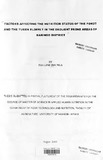| dc.description.abstract | A cross-sectional study was conducted between January and March 2001 to assess the risk
factors to nutritional vulnerability of elderly people. I n this context, the "elders" are defined
as people with 55 years and over. Since few Tugen and Pokot elderly knew their age, most
related the dates of their births to family, local or national events. The research was carried
out among Tugens and Pokot tribes living in the drought prone areas of Baringo district.
Socio-demographic, socio-economic, anthropometric and dietary data were collected in 250
households of elderly population (90 Tugens and 180 Pokots). Most people (87.2%)
depended on food relief provided by World Food Programme.
The results of the study revealed that the overall nutritional status was poor. The majority of
the elderly (82.4%) had a Body Mass Index of less than18.5 (about 78.8% and 88.9%
respectively for Pokots and Tugens). Food intakes were poor in quality and in quantity.
Slightly less than a quarter of the population (24.5%) took at least 2 meals per day. Most
nutrient intakes were below 50% of requirements except for iron (75.2%) and vitamin A
(65.6%) whose source was cereals and vegetables.
Dental problems were common for most of the elders (in 88.4%), which affects their
chewing ability.
There was an association (p <0.05) between malnutrition and marital status, animal
ownership, taking care of young children, size of the household and taking lunch.
Moreover it was found that when the population grows old, it tends to skip some meals
therefore decreasing the number of meals eaten. Body muscle loss increased significantly as
the population grew old.
Social factors such as taking care of young children or living in large households were
associated with high prevalence of malnutrition. Loneliness was a risk factor only for the
elderly who lost their partners. The number of cows owned and the capacity to care after
oneself, showed a positive impact on current BMI status.
Compared to the Pokots, Tugen elders reported higher proportion of malnutrition, about 2
times more likely to be malnourished (OR: 2.2; 95% CI: 1.1-4.6). The findings of the study
showed that the difference in nutritional vulnerability among the two communities may be
due to the gap in socio-economic factors such as marital status, household size, access to
food and source of income; and in their eating habits.
In conclusion, the study revealed associations between poverty, psychosocial/emotional,
family life, and food intake factors with nutritional status among elderly living in Baringo
district. Compared to the Pokots Tugen elders are at high level of nutritional vulnerability.
The findings suggest that more nutrition education and feeding programmes targeting old
people need to be designed and implemented in Baringo District. | en |

